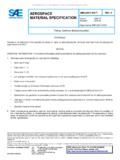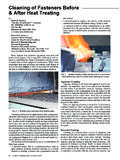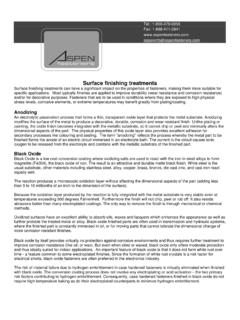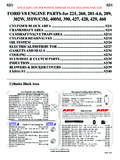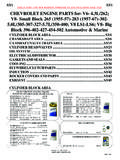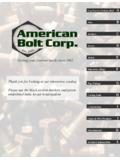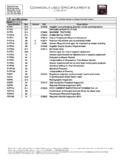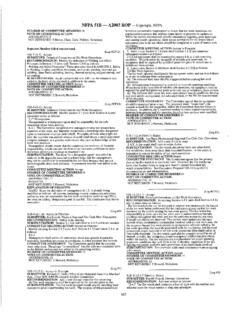Transcription of AEROSPACE AMS-QQ-P-416™ REV. E MATERIAL …
1 _____ SAE Technical Standards Board Rules provide that: This report is published by SAE to advance the state of technical and engineering sciences. The use of this report is entirely voluntary, and its applicability and suitability for any particular use, including any patent infringement arising therefrom, is the sole responsibility of the user. SAE reviews each technical report at least every five years at which time it may be revised, reaffirmed, stabilized, or cancelled. SAE invites your written comments and suggestions. Copyright 2016 SAE International All rights reserved. No part of this publication may be reproduced, stored in a retrieval system or transmitted, in any form or by any means, electronic, mechanical, photocopying, recording, or otherwise, without the prior written permission of SAE.
2 TO PLACE A DOCUMENT ORDER: Tel: 877-606-7323 (inside USA and Canada) Tel: +1 724-776-4970 (outside USA) Fax: 724-776-0790 Email: SAE WEB ADDRESS: SAE values your input. To provide feedback on this Technical Report, please visit AEROSPACE MATERIAL SPECIFICATION AMS-QQ-P-416 REV. E Issued 2000-07 Revised 2016-01 Superseding AMS-QQ-P-416D Plating, Cadmium (Electrodeposited) RATIONALE Revision E of AMS-QQ-P-416 corrects the errors in Table 1a and removes the 24 hours minimum from the drying time requirement of NOTICE ORDERING INFORMATION: The following information shall be provided to the plating processor by the purchaser. 1. Purchase order shall specify not less than the following: AMS-QQ-P-416E Type (see ) Class (see ) Lot hydrogen embrittlement testing if required (see ) and sampling (see ) Basis metal to be plated Tensile strength or hardness of the basis metal (see ) Preplate stress relief to be performed by plating processor (time and temperature) if different from Special features, geometry or processing present on parts that requires special attention by the plating processor Hydrogen embrittlement relief to be performed by plating processor (parameters or reference document) if different from Quantity of pieces to be plated.
3 2. Parts manufacturing operations such as heat treating, forming, joining and media finishing can affect the condition of the substrate for plating, or, if performed after plating, could adversely affect the plated part. The sequencing of these types of operations should be specified by the cognizant engineering organization or purchaser and is not controlled by this specification. Downloaded from SAE International by Carmen Lepe, Monday, January 25, 2016 SAE INTERNATIONAL AMS-QQ-P-416 E Page 2 of 16 1. SCOPE This specification covers the requirements for electrodeposited cadmium plating. Classification Cadmium plating shall be of the following types and classes, as specified (see Ordering Information): Types I - As plated II - With supplementary chromate treatment (see ) III - With supplementary phosphate treatment (see ).
4 Classes 1 - inch, minimum 2 - inch, minimum 3 - inch, minimum. Safety-Hazardous Materials While the materials, methods, applications, and processes described or referenced in this specification may involve the use of hazardous materials, this specification does not address the hazards which may be involved in such use. It is the sole responsibility of the user to ensure familiarity with the safe and proper use of any hazardous materials and to take necessary precautionary measures to ensure the health and safety of all personnel involved. 2. APPLICABLE DOCUMENTS The issue of the following documents in effect on the date of the purchase order forms a part of this specification to the extent specified herein.
5 The supplier may work to a subsequent revision of a document unless a specific document issue is specified. When the referenced document has been cancelled and no superseding document has been specified, the last published issue of that document shall apply. SAE Publications Available from SAE International, 400 Commonwealth Drive, Warrendale, PA 15096-0001, Tel: 877-606-7323 (inside USA and Canada) or +1 724-776-4970 (outside USA), AMS2750 Pyrometry ASTM Publications Available from ASTM International, 100 Barr Harbor Drive, Box C700, West Conshohocken, PA 19428-2959, Tel: 610-832-9585, ASTM B117 Operating Salt Spray (Fog) Apparatus ASTM B244 Measurement of Thickness of Anodic Coatings on Aluminum and of other Nonconductive Coatings on Nonmagnetic Basis Metals with Eddy-Current Instruments ASTM B487 Measurement of Metal and Oxide Coating Thicknesses by Microscopical Examination of a Cross Section ASTM B499 Measurement of Coating Thicknesses by the Magnetic Method.
6 Nonmagnetic Coatings on Magnetic Basis Metals ASTM B504 Measurement of Thickness of Metallic Coatings by the Coulometric Method ASTM B567 Measurement of Coating Thickness by the Beta Backscatter Method Downloaded from SAE International by Carmen Lepe, Monday, January 25, 2016 SAE INTERNATIONAL AMS-QQ-P-416 E Page 3 of 16 ASTM B568 Measurement of Coating Thickness by X-Ray Spectrometry ASTM B571 Qualitative Adhesion Testing of Metallic Coatings ASTM E29 Using Significant Digits in Test Data to Determine Conformance with Specifications ASTM E376 Measuring Coating Thickness by Magnetic-Field or Eddy-Current (Electromagnetic) Testing Methods ASTM F519 Mechanical Hydrogen Embrittlement Evaluation of Plating/Coating Processes and Service Environments Government Publications Copies of these documents are available online at TT-C-490 Cleaning Methods for Ferrous Surfaces and Pretreatments for Organic Coatings MIL-DTL-5002 Surface Treatments and Inorganic Coatings for Metal Surfaces of Weapons Systems MIL-STD-1916 DoD Preferred Methods of Acceptance of Product AIA Publications Available from AEROSPACE Industries Association, 1000 Wilson Boulevard, Suite 1700, Arlington, VA 22209-3928, Tel.
7 703-358-1000, NASM1312-1 Fastener Test Methods - Method 1, Salt Spray NASM1312-5 Fastener Test Methods - Method 5, Stress Durability NASM1312-12 Fastener Test Methods - Method 12, Thickness of Metallic Coatings NASM1312-14 Fastener Test Methods - Method 14, Stress Durability, Internally Threaded 3. REQUIREMENTS Materials The materials used shall be such as to produce platings that meet the requirements of this specification. Inventory Items in inventory that were plated prior to the issuance of this amendment may be used until the supply is exhausted. General Requirements Unless otherwise specified (see Ordering Information) parts having an ultimate tensile strength of greater than 200 ksi (or HRC 43) shall not be plated in accordance with this specification.
8 Preplate Stress Relief Steel parts which have been machined, ground, cold-formed, or cold-straightened after heat treatment, shall be stress relieved in accordance with Table 1 or Table 1A, as applicable. Stress relief shall precede shot peening, cleaning, and plating for relief of damaging residual tensile stresses. Stress relief is not required for fasteners if all cold working is limited to cold working of the head-to-shank fillet and thread rolling after heat treatment. Downloaded from SAE International by Carmen Lepe, Monday, January 25, 2016 SAE INTERNATIONAL AMS-QQ-P-416 E Page 4 of 16 Cleaning All parts shall be cleaned in accordance with MIL-DTL-5002.
9 Fasteners heat treated to 160 ksi (or 36 HRC) or above, shall be cleaned in accordance with MIL-DTL-5002 and the following: a. Abrasive cleaning shall be used for removal of heat treat scale and oxidation as applicable (pickling is not permitted). b. Alkaline cleaning shall be used as applicable with anodic (reverse) current or no current. Cathodic (direct) current cleaning with the part serving as the cathode shall not be used. c. A clean water rinse shall be used as applicable following each cleaning or plating operation. d. Surface activation of the part in an inhibited acid is acceptable for purposes of plating adhesion. Plating Application The plating shall be applied after all basis metal heat treatments and mechanical operations, such as machining, brazing, welding, forming and perforating of the article, have been completed.
10 Underplating Cadmium shall be deposited on the basis metal without a preliminary plating of other metal, except in the case of parts made of corrosion resistant alloys on which a preliminary plating of nickel or copper may be necessary, or on parts made of aluminum on which a preliminary treatment, such as the zincate process or preliminary plating of copper or electroless nickel, may be necessary. Coverage The plating shall cover all surfaces as stated in , including roots of threads, corners, and recesses. Hydrogen Embrittlement Relief Treatment All parts shall be baked within 4 hours after the plating operation is completed as specified in Table 1 or Table 1A, as applicable.



